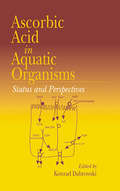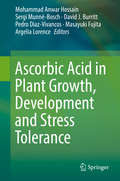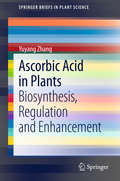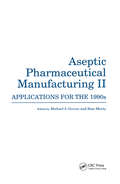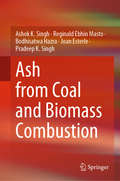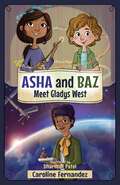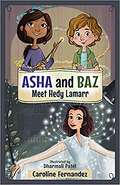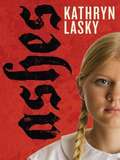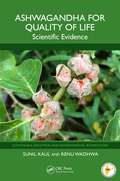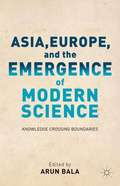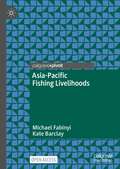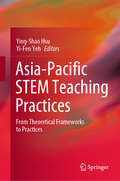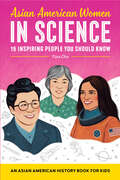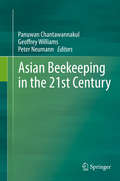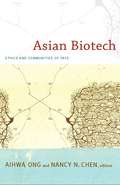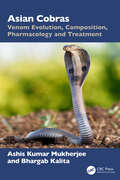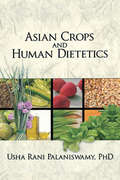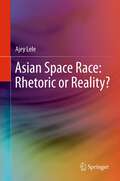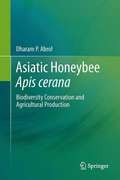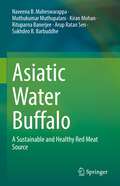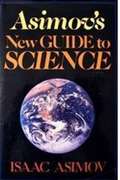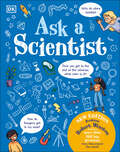- Table View
- List View
Ascorbic Acid In Aquatic Organisms: Status and Perspectives
by Konrad DabrowskiWe are just beginning to discover the importance of vitamin C in the health of natural and man-made ecosystems. Synthesis of ascorbic acid is well understood, but algae as the only source of ascorbate in the aquatic food pyramid has not been explored. There is an expanding field of the culture of aquatic organisms that demand formulated feeds to be
Ascorbic Acid in Plant Growth, Development and Stress Tolerance
by Argelia Lorence Masayuki Fujita Mohammad Anwar Hossain Pedro Diaz-Vivancos Sergi Munné-Bosch David J. BurrittLatest research on ascorbate metabolism in plants.<P><P> Contributed by an international panel of experts.<P> Comprehensive review on antioxidant pathways and physiology for plant funtions.<P> Ascorbic acid (AsA), vitamin C, is one of the most abundant water-soluble antioxidant in plants and animals. In plants AsA serves as a major redox buffer and regulates various physiological processes controlling growth, development, and stress tolerance. Recent studies on AsA homeostasis have broadened our understanding of these physiological events. At the mechanistic level, AsA has been shown to participate in numerous metabolic and cell signaling processes, and the dynamic relationship between AsA and reactive oxygen species (ROS) has been well documented. Being a major component of the ascorbate-glutathione (AsA-GSH) cycle, AsA helps to modulate oxidative stress in plants by controlling ROS detoxification alone and in co-operation with glutathione. In contrast to the single pathway responsible for AsA biosynthesis in animals, plants utilize multiple pathways to synthesize AsA, perhaps reflecting the importance of this molecule to plant health. Any fluctuations, increases or decreases, in cellular AsA levels can have profound effects on plant growth and development, as AsA is associated with the regulation of the cell cycle, redox signaling, enzyme function and defense gene expression. Although there has been significant progress made investigating the multiple roles AsA plays in stress tolerance, many aspects of AsA-mediated physiological responses require additional research if AsA metabolism is to be manipulated to enhance stress-tolerance. This book summarizes the roles of AsA that are directly or indirectly involved in the metabolic processes and physiological functions of plants. Key topics include AsA biosynthesis and metabolism, compartmentation and transport, AsA-mediated ROS detoxification, as well as AsA signaling functions in plant growth, development and responses to environmental stresses. The main objective of this volume is therefore to supply comprehensive and up-to-date information for students, scholars and scientists interested in or currently engaged in AsA research.
Ascorbic Acid in Plants: Biosynthesis, Regulation and Enhancement (SpringerBriefs in Plant Science)
by Yuyang ZhangAscorbate acid (AsA) is an important antioxidant in plants, playing important roles in various physiological processes. Humans have lost the ability to synthesize AsA because of the lack of L-gulono-1,4-lactone oxidoreductase, and thus have to absorb ascorbate from diet including fresh fruits and vegetables, as they are the major sources of ascorbate. Several pathways for AsA biosynthesis and metabolism have been identified in plants since 1998. More attention has been paid to improving ascorbate content in plants especially in fruits and vegetables. Significant progresses have been made on key enzymes and genes involved in the AsA biosynthesis and metabolism. Recently, more interests have arised in the regulation of AsA biosynthesis, as it is constantly regulated by the plant development and the environmental factors, e.g. light. Ascorbic acid is also frequently reported to affect plant growth and development e.g. flowering time and fruit ripening. The scope of the book is to cover the biological role, biosynthesis and metabolism, regulation, and metabolic modification of ascorbate in plants.
Aseptic Pharmaceutical Manufacturing II: Applications for the 1990s
by Michael J. Groves; Ram MurtyAsceptic Pharmaceutical Manufacturing II explores the sophisticated technology, developments, and applications that allow aseptic processing to approach the sterility levels achieved with terminal sterilization. Written by experts in sterile manufacturing, this book covers aseptic technology, developments, and applications and makes a valuable contribution to understanding the issues involved in aseptic manufacture. Topics include the processing of biopharmaceuticals, lyophilization, personnel training, radiopharmaceuticals, hydrogen peroxide vapor sterilization, regulatory requirements, validation, and quality systems.
Ash from Coal and Biomass Combustion
by Bodhisatwa Hazra Pradeep K. Singh Ashok K. Singh Reginald Ebhin Masto Joan EsterleThis is a concise book with comprehensive information on coal and biomass ash generated from their combustion in thermal power plants. It presents detailed studies on ash generated from contrasting coal and biomass feedstocks, and provides a comparative evaluation of these different ashes in terms of their origin, properties, environmental hazards. Potential utilizations with specific advantages and disadvantages of the respective ashes are elaborated in detail, including some innovative means of ash utilization for value addition purposes. By addressing both the theory and commercial exploitation of these products, this book will be helpful for industrialists, academicians and researchers alike.
Asha and Baz Meet Gladys West (Asha and Baz)
by Caroline FernandezAsha and Baz face a class challenge about cardinal directions (North, East, South, West). They travel back in time to meet Gladys West whose math helped to create modern-day GPS.While visiting the community garden with their class, their teacher assigns a challenge: use a compass rose and a map to uncover parts of a secret message hidden around the garden.When trying to follow the instructions on the map leaves the best friends feeling lost, they look to the past for guidance. Together, they magically travel to 1978, to meet mathematician Gladys West.Gladys is working on her own important project using a satellite to map the ocean, and with her help, Asha and Baz might just find their way.
Asha and Baz Meet Hedy Lamarr (Asha and Baz)
by Caroline FernandezStarred review in The Canadian Children's Book Centre's Best Books For Kids and Teens 2023 Fall edition! In the second book of Caroline Fernandez&’s Asha and Baz series, readers once more dive into the past—this time to learn about famous actor and inventor Hedy Lamarr! Computer class is off to a rocky start for Asha and Baz! They&’ve been given a Coding Challenge and must correctly code instructions to send a digital frog across a computer screen. But they can&’t seem to figure it out. With their reputation as the smartest kids in their class at stake, the pair turn to their magic stick for answers. They use it to draw their coding problem in the sand and are transported back in time to 1941 Hollywood to meet Hedy Lamarr, leaving them even more confused: How can an actor help them solve the Coding Challenge? But when they learn there&’s a war happening and that Hedy Lamar has been hard at work inventing a device to help with war efforts, the kids realize her problem-solving skills may be just what they need. Coding, frequency hopping, and more await in Asha and Baz Meet Hedy Lamarr!
Asha and Baz Meet Mary Sherman Morgan (Asha and Baz)
by Caroline FernandezJoin Asha and Baz on an out-of-this-world adventure as they compete to win a chance to meet astronaut Chris Hadfield with their paper rocket launch. The only catch? They don't know how to power their rocket! Watch as they travel back in time to meet the pioneering rocket scientist Mary Sherman Morgan for help.Asha and Baz Meet Mary Sherman Morgan is an exciting and educational tale that introduces young readers to the world of science and space exploration in a fun and engaging way. With vibrant illustrations and a captivating storyline, this book about rockets is perfect for kids who love adventure, history, and learning about real-life heroes in STEM fields. Get ready for a rocket-fueled journey that will inspire young minds to reach for the stars!A TD Summer Reading Club selectionA Top Grade Books Fall 2022 selection for Early ReadersA 2022 Globe & Mail Kids' Gift Guide selectionA 2023 Next Generation Indie Book Awards Finalist - Children&’s/Juvenile Early Readers/Chapter Books (Fiction)
Ashes
by Kathryn LaskyBerlin, 1932. Thirteen-year-old Gabriella Schramm's world is slowly, but steadily, crumbling as Adolf Hitler rises to power. <P><P>The only thing that soothes Gabriella is her favorite pastime-reading. <P><P>But then her country's tensions rise, the streets fill with soldiers, Gaby's sister's boyfriend raises his arm in a heil Hitler salute, and a family friend-Albert Einstein-flees the country. <P><P>And her only solace-her books-come under attack. Will Gaby have to leave behind the stories-and the life-that she has always loved?
Ashwagandha for Quality of Life: Scientific Evidence (Sustainable Industrial and Environmental Bioprocesses)
by Renu Wadhwa Sunil KaulThis book offers a comprehensive overview of the scientific evidence supporting the diverse health benefits of Ashwagandha. Each chapter delves into specific aspects, exploring its effects on stress management, cognitive function, physical performance, immune system support, sleep quality, and hormonal balance. Through an evidence-based approach, the text aims to bridge the gap between traditional wisdom and modern scientific understanding, presenting Ashwagandha as a promising herb for enhancing quality of life. Ashwagandha for Quality of Life: Scientific Evidence begins by highlighting the origin and botanical characteristics of Ashwagandha and explores the wide range of its traditional and modern applications. By identifying the main active compounds and their functions, readers gain insight into the herb's potential physiological effects. Further, the book investigates Ashwagandha's potential for preventing and treating COVID-19. The book is intended for general readership, herbalists, naturopaths, alternative medicine practitioners, and life science/medical students and researchers to gain a comprehensive understanding of Ashwagandha's potential in improving health and well-being, while also emphasizing the importance of quality and chemotyping for optimal benefits.
Asia, Europe, And The Emergence Of Modern Science: Knowledge Crossing Boundaries
by Arun BalaThis volume brings together essays from leading thinkers to examine what role Asian traditions of knowledge played in the rise of modern science in Europe, the implications this has for the epistemology of science, and whether pre-modern Asian traditions can provide resources for advancing scientific knowledge in future.
Asia-Pacific Fishing Livelihoods
by Kate Barclay Michael FabinyiThis open access book explores fishing livelihoods in the context of the wider contexts in which they are embedded. Drawing on case studies from across the Asia-Pacific region, the book highlights how fishing livelihoods are shaped by globalisation, social relationships and governance. The book concludes by showing how better understanding these relationships can contribute to governance for healthier ecosystems and social wellbeing.This is an open access book.This is an open access book.
Asia-Pacific STEM Teaching Practices: From Theoretical Frameworks to Practices
by Ying-Shao Hsu Yi-Fen YehThis book offers various perspectives on the complex and crosscutting concepts of the science, technology, engineering, and mathematics (STEM) disciplines in the classroom context. Presenting empirical studies, it reveals how researchers in the Asia-Pacific Region planned and implemented STEM education in the classroom. Further, it discusses the assessment of STEM learning to clarify what important elements should be included and how researchers and educators frame and design assessment tools. The book consists of four parts: potential and trends in STEM education; teachers’ practical knowledge for STEM teaching; STEM teaching practices; and assessment of STEM learning. Providing evidence on developing curriculums, implementing instructional practices and educating classroom teachers, it is intended for readers wanting to explore STEM education from multiple perspectives.
Asian American Women in Science: An Asian American History Book for Kids (Biographies for Kids)
by Tina ChoStories of amazing Asian American women who broke barriers in science—for kids ages 8 to 12 Kazue Togasaki was one of the first Japanese American women to become a doctor. Chien-Shiung Wu was a Chinese American physicist who worked on top-secret projects. Isabella Aiona Abbott became an expert on the marine plant life of her native Hawaii. Asian American women are a huge part of scientific discovery, and this collection of biographies for kids explores 15 brilliant women, and how they used their intelligence and determination to overcome challenges and succeed. Open up this Asian American children's book and meet some of the scientists who helped: Pave the way—Find out how people like inventor Alice Min Soo Chun and computer programmer Josephine Jue designed amazing new technology and spent time educating others. Heal the sick—Learn about doctors like Joan Block and Jacqueline Whang-Peng who revolutionized how we treat diseases like hepatitis B and cancer. Explore new worlds—Discover how botanist Roseli Ocampo-Friedmann and mathematician Angelita Castro-Kelly changed the way we think about outer space. Dive into a world of inspiring women with this science-focused entry into Asian American books for kids.
Asian Beekeeping in the 21st Century
by Geoffrey Williams Peter Neumann Panuwan ChantawannakulFrom the perspective of local scientists, this book provides insight into bees and beemanagement of Asia, with a special focus on honey bees.Asia is home to at least nine honey bee species, including the introduced European honeybee, Apis mellifera. Although A. mellifera and the native Asian honey bee, Apis cerana,are the most commonly employed species for commercial beekeeping, the remainingnon-managed native honey bee species have important ecological and economic roleson the continent. Species distributions of most honey bee species overlap in SoutheastAsia, thus promoting the potential for interspecies transmission of pests and parasites,as well as their spread to other parts of the world by human translocation.Losses of managed A. mellifera colonies is of great concern around the world, includingin Asia. Such global colony losses are believed to be caused, in part, by pests andparasites originating from Asia such as the mite Varroa destructor, the microsporidianNosema ceranae, and several bee viruses.Taking advantage of the experience of leading regional bee researchers, this book providesinsight into the current situation of bees and bee management in Asia. Recentintroductions of honey bee parasites of Asian origin to other parts of the world ensuresthat the contents of this book are broadly relevant to bee scientists, researchers, governmentoffi cials, and the general public around the world.
Asian Biotech: Ethics and Communities of Fate
by Aihwa Ong Nancy N. ChenProviding the first overview of Asia's emerging biosciences landscape, this timely and important collection brings together ethnographic case studies on biotech endeavors such as genetically modified foods in China, clinical trials in India, blood collection in Singapore and China, and stem-cell research in Singapore, South Korea, and Taiwan. While biotech policies and projects vary by country, the contributors identify a significant trend toward state entrepreneurialism in biotechnology, and they highlight the ways that political thinking and ethical reasoning are converging around the biosciences. As ascendant nations in a region of postcolonial emergence, with an "uncanny surplus" in population and pandemics, Asian countries treat their populations as sources of opportunity and risk. Biotech enterprises are allied to efforts to overcome past humiliations and restore national identity and political ambition, and they are legitimized as solutions to national anxieties about food supplies, diseases, epidemics, and unknown biological crises in the future. Biotechnological responses to perceived risks stir deep feelings about shared fate, and they crystallize new ethical configurations, often re-inscribing traditional beliefs about ethnicity, nation, and race. As many of the essays in this collection illustrate, state involvement in biotech initiatives is driving the emergence of "biosovereignty," an increasing pressure for state control over biological resources, commercial health products, corporate behavior, and genetic based-identities. Asian Biotech offers much-needed analysis of the interplay among biotechnologies, economic growth, biosecurity, and ethical practices in Asia. Contributors Vincanne Adams Nancy N. Chen Stefan Ecks Kathleen Erwin Phuoc V. Le Jennifer Liu Aihwa Ong Margaret Sleeboom-Faulkner Kaushik Sunder Rajan Wen-Ching Sung Charis Thompson Ara Wilson
Asian Citrus Psyllid: Biology, Ecology and Management of the Huanglongbing Vector
by Sidney Altman Sandra A Allan Antonio Juliano Ayres El-Desouky Ammar George A Beattie Michael J Boyle Liliana Cano Joseph M Cicero Sasha-Kay V Clarke ELIZABETH E GRAFTON-CARDWELL Susan Halbert David G Hall Michelle Heck Chris S Holland Wayne B Hunter Richard W Mankin Greg Mccollum Jackie L Metz Godfrey Miles Marcelo Pedreira Miranda Cesar Monzo Thomson M Paris K S Pelz-Stelinski Barukh Rohde Andres F Sandoval-Mojica Mamoudou Sétamou Robert G Shatters Jr Burton Singer John M TomichAsian citrus psyllid (ACP), Diaphorina citri, is an insect pest which transmits a bacterium, Candidatus Liberibacter asiaticus (CLas), primarily through feeding in newly emergent foliage of citrus trees. This pathogen causes a disease known as Huanglongbing (HLB), or citrus greening, which has become the most debilitating and intractable disease in citrus crops. This book, written by a team of experts on the Asian citrus psyllid, gathers together everything currently known about the biology and ecology of this important pest species, examines the transmission and acquisition processes of the pathogen, and looks at current management practices and their effectiveness. The potential for new, innovative management techniques are also described, along with the economic implications of managing this rapidly establishing disease. This book: Covers all aspects of Asian citrus psyllid biology and ecology for the first time in one place. Examines new, innovative management practices and assesses their effectiveness. Discusses the vector-pathogen relationship in detail. Explains the economics of controlling this devastating pest. This title is essential reading for all researchers involved in the management and control of Asian citrus psyllid, extension agents, and pest management consultants. It will also be of great use to graduate students in applied entomology and related disciplines.
Asian Cobras: Venom Evolution, Composition, Pharmacology and Treatment
by Ashis Kumar Mukherjee Bhargab KalitaThis book comprehensively explores Asian Cobras, covering their evolutionary history, geographic distribution, venom characteristics, pathophysiology of envenomation, and treatment strategies. The introductory chapters focus on venomous snakes, placing particular emphasis on cobras and the substantial impact of snake envenomation in Asia, where it is recognized as a neglected tropical disease. The venom delivery system, including glands, dentition, and fangs, is explored in detail. The book also explores their appearance, behavior, habitat, feeding, and mating habits, along with their geographic distribution across Asia. Further, the chapters examine the venom composition of different cobra species, highlighting the variations within and between species as well as across geographic regions, supported by advanced biochemical and proteomic analyses. The medical consequences of cobra envenomation are examined, focusing on clinical manifestations such as neurotoxicity, cytotoxicity, and other serious complications, while emphasizing the role of venom variability in determining the severity of envenomation.Key Features: Offers an in-depth overview of the evolution, taxonomy, and ecology of Asiatic cobras Explores the variability in cobra venom composition across different species and geographic regions, supported by cutting-edge biochemical, proteomic, and transcriptomic research Highlights the clinical manifestations of cobra envenomation, including neurotoxicity and cytotoxicity, and emphasizes the pathophysiological differences among cobra species Reviews the latest approaches in treating cobra envenomation, including the use of antivenoms and drug therapies Stresses the importance of public education, government initiatives, and NGOs in addressing cobra envenomation as a neglected tropical disease This book is a valuable source for researchers of toxinology, biochemistry, biotechnology, and biomedical sciences.
Asian Crops and Human Dietetics
by Usha R. PalaniswamyGo beyond the nutritional value to discover the lesser known health benefits of certain Asian crops Several foods from the Asian culture that are not well known to other parts of the world have health benefits that stretch beyond mere nutritional value. Asian Crops and Human Dietetics comprehensively reviews the plants and spices in the A
Asian Space Race: Rhetoric Or Reality?
by Ajey LeleThis book explores the character and contours of the Asian Space Powers. At present, Asian states like China, Japan and India are found investing in space technologies with analogous social and scientific and probably with divergent military intents. Other Asian states like Israel, South Korea and Malaysia are also making investments in the space arena. States like Iran and North Korea are faulted for using space launches as a demonstrative tool to achieve strategic objectives. This work examines this entire maze of activities to unearth where these states are making these investments to accomplish their state-specific goal or are they also trying to surpass each other by engaging in competition. Explaining why and how these states are making investments towards achieving their socio-economic and strategic mandate this book infers that the possibility of Asian Space Race exists but is presently fairly diminutive.
Asiatic Honeybee Apis cerana: Biodiversity Conservation and Agricultural Production
by Dharam P. AbrolDespite its economic usefulness, biodiversity of Asian hive bee Apis cerana is suffering precipitous decline and is threatened with extinction in its entire native habitat. Although a number of publications have appeared on honeybees in the market no attempt has been made to approach the subject in systematically and in a comprehensive manner in case of Apis cerana. There is still not enough knowledge on different facets of biological conservation, agricultural production and role in improving food security and livelihoods. An attempt has been made in this book to fill the gap by providing detailed information on different aspects of Apis cerana leading to sustainability and environmental protection. This book discusses information on varied aspects of Apis cerana biology, biogeography, reproduction, genetics, molecular phylogeny, interaction with other species, floral resources, dance language, safety from pesticides, management problems, loss of genetic diversity, behavioural defence, role in food production, livelihood security and conservation strategies for protecting biodiversity and enhancing crop productivity. The compilation of this book is unique in the sense that in the context of pollinator decline over the world, conservation of this species will be a step for sustaining food security.
Asiatic Water Buffalo: A Sustainable and Healthy Red Meat Source
by Rituparna Banerjee Naveena B. Maheswarappa Muthukumar Muthupalani Kiran Mohan Arup Ratan Sen Sukhdeo B. BarbuddheThis need-based unique book deals exclusively with water buffalo (Bubalus bubalis) meat to provide much needed information to thousands of buffalo meat processors across the world. The information provided in this first-of-its-kind book on buffalo meat quality, nutritional characteristics, safety, and processing can be utilized by buffalo meat producers and meat processors for the advancement of the buffalo meat sector. It also provides valuable information to faculty members, students, researchers, and all other readers interested in this new source of meat. Owing to the limited research and scientific literature available on buffalo meat, the authors’ own research findings and our experiences were included wherever required to give crisp, practical, and complete information. The information proposed in this book should be beneficial to the entire buffalo industry, from the farming and processing of buffaloes to the marketing of products. This serve as a handy guide to meat scientists, faculty members, and students willing to learn more about buffalo meat processing. Up-to-date relevant references were also included for the benefit of researchers and students to enable them to easily access further information. Above all, it provides valuable information to consumers who are interested to know this new and potential source of meat.
Asimov's New Guide to Science
by Isaac AsimovThis is a large book containing sections on physics, the universe, early science, scientists, etc. This book is very large but is written in Asimov's usual, clear style.
Ask A Scientist (New Edition): Professor Robert Winston Answers More Than 100 Big Questions From Kids Around the World!
by Robert WinstonRobert Winston answers 100 big questions from kids across the world in this fun and unique science book.In this unique science book, Professor Robert Winston answers more than 100 real-life questions from children all around the world! And who could be a better scientist to ask questions to than Professor Robert Winston? Ask a Scientist puts the fun back into science in this thrilling book for children aged 6-9. All the popular science topics are covered, with weird and wacky questions and clear and lively answers, including biology: &“Why do freckles come in dots on your face?&”; physics: &“Could you jump off the world?&”; Earth: &“Why is the sky blue?&”; chemistry: &“Why are there bubbles in boiling water?&”; natural science: &“Do dogs cry?&”, and space: &“Why will the Sun explode and make us extinct?&”. This exciting new edition includes eight pages of additional questions relating to the recent hot topics in science, including the COVID-19 pandemic. Inside the pages of this quirky science book, you&’ll find: - Every aspect of science: including biology; space; physics; chemistry; Earth; natural sciences.- The topic of science presented in a fresh, exciting way, by tackling it from the child&’s perspective.- More than 100 real-life questions from children from all around the world about every aspect of science.- Updated reissue of the 2019 edition with an additional eight new pages, including coverage of important recent topics such as the COVID-19 pandemic.The inspiration behind this unique science book came from the many questions posed by Robert Winston&’s grandchildren and by children from the schools he has visited over the years. The book includes some of these questions, plus many more gathered from countries all over the world – including the UK, Ireland and mainland Europe, Canada, the USA, India, China, and Japan. The 100 big questions featured inside the book cover all the main science topics: chemistry, physics, biology, Earth, space, and natural science.
